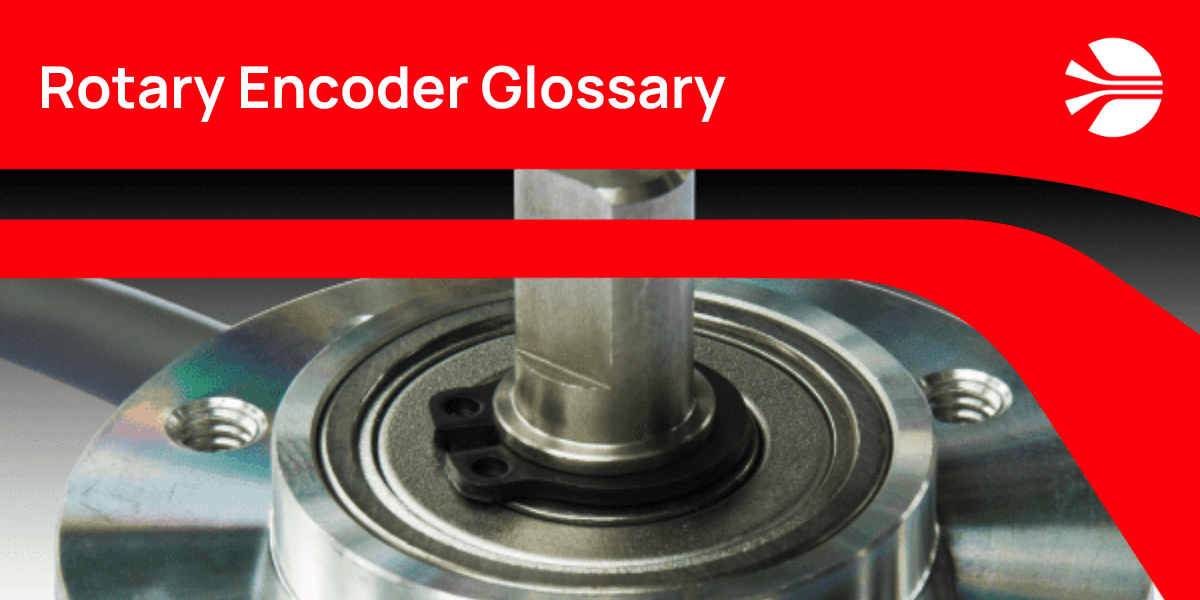[aioseo_breadcrumbs]
Rotary Encoder Glossary

This glossary defines common terms used when working with rotary encoders.
Encoder Types:
- Absolute Encoder: Provides a unique electrical signal for every possible shaft position. It remembers its position even after power is lost.
- Bearingless Encoder: An encoder that tracks position without a physical connection to the rotating shaft. Most often it consists of a fixed stator and a rotor that is mounted to the shaft.
- Hollow Shaft / Through-hole Encoder: Encoder in which the shaft passes through one side of the encoder and out the other
- Hubshaft / Blind-hollow Encoder: An encoder flange that accepts a shaft, but the shaft doesn’t pass through.
- Incremental Encoder: Outputs a pulse train corresponding to the shaft’s rotation. It tracks the total number of pulses since its last reference point but cannot determine absolute position without additional tracking.
- Kit Encoder: An encoder that consists of components, some which are fixed and others mounted to the shaft. Typically used by OEMs to reduce costs or in some instances smaller projects to minimize size.
- Miniature Encoder: Encoder generally 25mm outer diameter or smaller
- Multi-turn Encoder: Tracks the total number of revolutions alongside the position within a single revolution, providing absolute positioning information even after multiple rotations.
- Off-Axis Encoder: An encoder that has a full 360 degree rotor/track, but where the ‘readhead’ is located in just one fixed location over a small part of the overall 360 degree measurement range.
- Ring Encoder: An encoder where the rotating disc with the code pattern is shaped like a ring. The sensor is typically positioned in the center of the ring.
- Shaft Encoder: A general term for any encoder that uses a rotating shaft as the input for its measurements.
- Shaftless Encoder: Most commonly based on magnetic technology, an encoder where a rotor is placed in close proximity to the face of a stator, generally lower resolution compared to other encoders.
- Single-Turn Encoder: Measures rotation within a single revolution (usually 360 degrees).
Coding and Output:
- Analog: A common, low-cost standard with either a voltage or a current output.
- Binary Code: A digital code using only zeros and ones to represent positions.
- Bit Parallel – A binary or grady code where each bit has its own digital output line.
- BiSS-C: The BiSS Interface (bidirectional/serial/synchronous) protocol is an – Open Source – digital interface which enables a digital, serial and secure communication between controller, sensor and actuator.
- CANopen: A fieldbus protocol using CAN networks. CANopen is available on many PLCs and widely used in factory automation and mobile machines.
- Communication Interface: The method by which the encoder transmits its digital or analog output signal to a controller or other device.
- EtherCAT: An open high performance Ethernet-based Fieldbus system. EtherCAT require short data update times with low communication jitter and low hardware costs.
- EtherNet/IP: EtherNet/IP is an industrial communication protocol developed by Rockwell Automation and managed by ODVA. It is based on CIP and TCP/IP protocol.
- ETHERNET POWERLINK: ETHERNET POWERLINK is a real-time communication system based on Ethernet networks and managed by EPSG.
- Gray Code: A binary code variant where only one bit changes between adjacent code values, minimizing errors during transitions.
- IO-Link: IO-Link is a point-to-point interface allowing transmission of process, diagnosis and configuration data making devices ready for Industry 4.0.
- IP Rating: Indicates the level of protection against dust and water ingress. (e.g., IP65: dust-tight and protected from water jets)
- Latency: The time delay between a shaft movement and the corresponding electrical signal from the encoder.
- Modbus: Modbus is a serial protocol managed by the Modbus Organization
- PROFINET: PROFINET is an Industrial Ethernet standard from “PROFIBUS&PROFINET“ International designed for automation. Commonly used by Siemens PLCs.
- Pulse Width Modulation (PWM): A method for encoding a digital signal using pulse width variations.
- Quadrature: Quadrature output refers to the fact that for an incremental encoder signals A and B are separated by 90 degrees of phase shift with A leading B or B leading A depending on the direction of rotation.
- Pulses Per Revolution (PPR): The number of electrical pulses generated by the encoder for a complete revolution of the shaft.
- SAE J1939: SAE J1939 is a fieldbus standard used for communication by the off-highway vehicle and heavy-duty truck industry.
- SSI: SSI is a widely used RS-422 baked serial interface with point-to-point connection between PLC/Master and encoder.
Rotary Encoder Components:
- Flange: A mounting plate attached to the encoder housing for easy installation and secure positioning.
- Readhead: Part of the encoder that is generally fixed and reads the track/rotor.
- Resolver: An analog rotary position sensor that outputs sine and cosine waveforms corresponding to the shaft angle.
- Rotor: The rotating part of the encoder containing the code pattern.
- Stator: The stationary part of the encoder containing the sensor that detects the code pattern on the rotor.
Motor Terms:
- DC Brushless Motor: A type of direct current motor that utilizes electronic commutation rather than brushes to transfer current.
- DC Permanent Magnet Motor: A motor utilizing permanent magnets to produce a magnetic field. Has linear torque speed characteristics.
- Drive: An electronic circuit that controls the speed and direction of a motor.
- Motor: An electromechanical device that converts electrical energy into mechanical rotation.
- Servo Motor: A rotary actuator that precisely controls its angular position based on a control signal.
Stepper Motor: A specialized AC motor that allows discrete positioning without feedback. Normally used for non-critical, low power applications, since positional information is easily lost if acceleration or velocity limits are exceeded. Load variations can also cause loss of position. If encoders are used, these limitations can be overcome.
Still have questions, excellent! Contact Everight Position to learn more.
"*" indicates required fields

 856-727-9500
856-727-9500